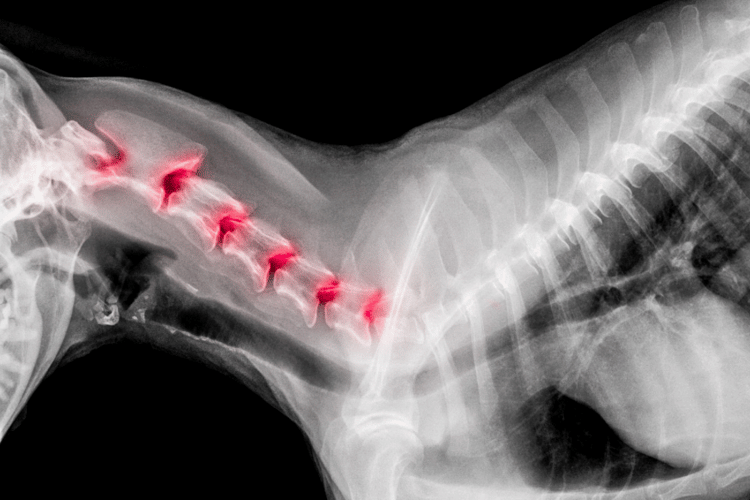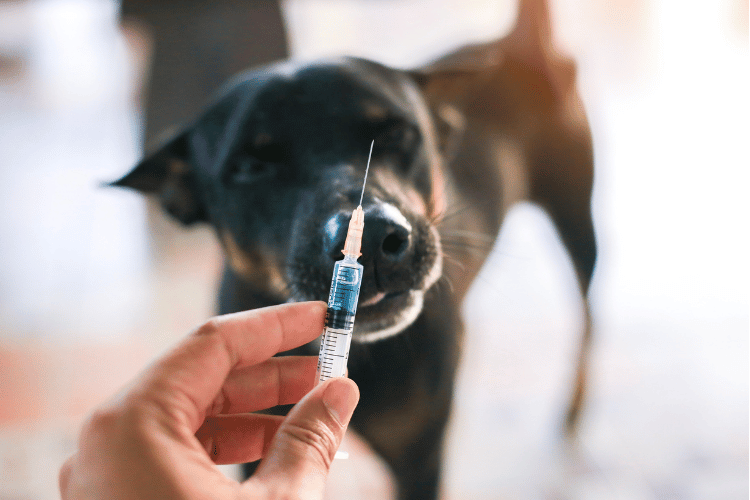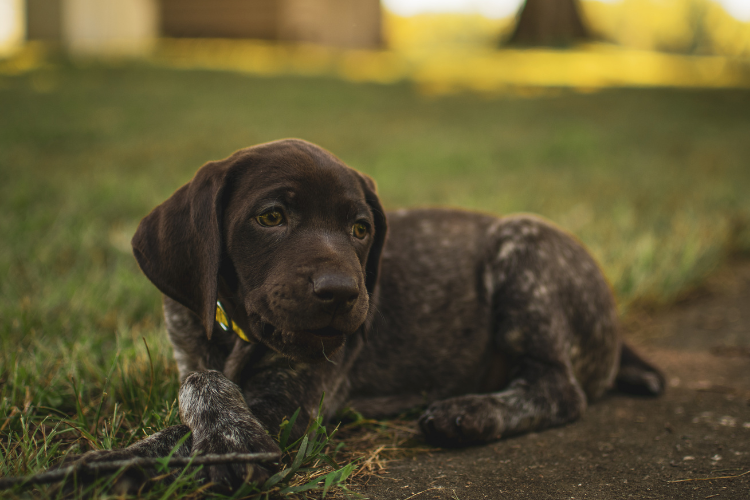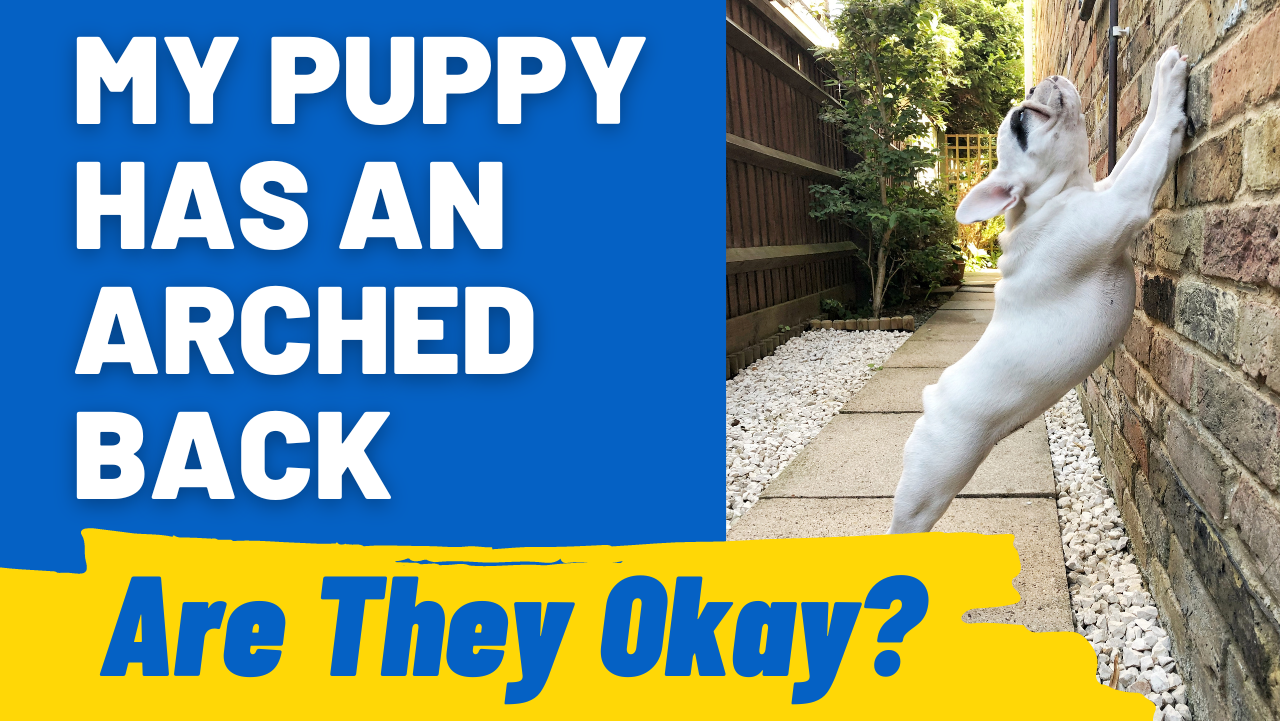Not only does a puppy that arches their back like a cat an unusual sight, but it’s also a cause for concern for many owners.
When a puppy’s back is arched, and it doesn’t seem like they’re normally stretching, it’s easy to assume that they’re in pain—and in most cases, they probably are.
There are many possible reasons why your puppy has an arched back, from abdominal pain to spinal conditions, like IVDD. In this article, we’ll review all of these and get you up to speed on what you need to know and when you need to worry.

Puppy Has a Curved Spine
Back arching in dogs is also called kyphosis. Dogs can stretch their back by arching, but if this behavior persists, it might indicate other health issues.
Genetics can play a role in a puppy’s curved spine. Some breeds give birth to puppies with spinal and vertebral defects.
Others may develop spine curvature later on in their lives, especially when they experience trauma to the back area from high activity levels. Unfortunately, since our pups usually enjoy playing and occasional hyper zoomies, they can cause trauma to their spinal areas.
Often, there isn’t just one way a pup’s spine curves. Below are some common examples of instances where your puppy exhibits a curved spine and the possible reason why.
Hunched Back When Sitting Only
Before rushing to the nearest vet clinic, determine when your puppy exhibits a curved spine. Are they doing it all the time or only under certain situations?
Silly as it is, sometimes dogs can adapt to weird sitting positions, including one where their back is hunched if relaxed. However, you should ensure that your puppy isn’t showing any signs of pain and that their back returns to normal when they walk.
Hunched Back With Tail Between Legs
A hunched back is also a common sign of pain or discomfort. A pup with a hunched back and tail between their legs is an even more convincing sign that they’re in some level of distress.
Hunched Back and Wobbly
An arching back paired with wobbly or off-balance walking is a hallmark symptom of Intervertebral Disc Disease or IVDD. This disease usually manifests as trembling, a common response to pain.
When you notice these signs, you have to bring your pup to the vet as soon as possible. With this disease, time is of the essence.
A vet visit is necessary when owners observe symptoms, even for mild ones. In the next section, we’ll tackle IVDD in-depth and the symptoms to watch out for.
What Is Intervertebral Disc Disease?

Intervertebral Disc Disease, or IVDD, is a spinal disorder that causes degenerative neurologic and mobility problems. This is why an arched back, combined with a wobbly gait, may indicate IVDD.
It’s also important to note that chondrodystrophic breeds are predisposed to this condition. Chondrodystrophic breeds include Dachshunds, Beagles, Pembroke Welsh Corgis, Lhasa Apsos, and Basset Hounds.
IVDD can happen from trauma that ultimately leads to spinal cord compression.
Due to the extreme force brought about by the trauma, the intervertebral discs or the shock absorbers of your dog’s spine can harden. This hardening can lead to nerve damage, paralysis, and severe pain.
Unfortunately, trauma can come from any activity, especially for active puppies.
This is why it’s important to choose a dog pen that’s fit for them when you first take them home. The right pen will ensure they have a safe space to play in when you can’t give them your full attention.
However, IVDD can also happen over time. The intervertebral discs can harden as our dogs get older.
Does My Dog Have Intervertebral Disc Disease?
The best and only way to determine if your dog has intervertebral disc disease is to consult a veterinarian. They are the only ones who can fully examine and diagnose your pet.
Veterinarians will perform a physical exam to rule out orthopedic problems. They’ll run several tests and assess your dog’s neurologic state.
It’s difficult and dangerous to self-diagnose our pets, especially for conditions like IVDD, where early detection is key. The disease can progress quickly, even if the initial signs appear like they aren’t an issue.
That said, dog owners should know the symptoms to watch out for, especially if they have chondrodystrophic breeds.
Are you interested in reading post How Come Dogs Don’t Live Long?
Symptoms of IVDD
Aside from the arched back and the unsteady gait, below are other IVDD symptoms to take note of.
- Refusal to walk
- Knuckling while walking
- Difficulty passing urine and feces
- Inability or reluctance to stand
- Involuntary shivering, trembling, or shaking
Your dog can show other signs of pain and discomfort, such as crying or whimpering. In addition, when our pets are in pain, there’s usually a loss of appetite, lethargy, and flattened ears.
Remember that signs can appear mild at first, but since this condition progresses fast, more severe symptoms, like paralysis, can also manifest.
Treatment Options for IVDD
The key to successfully combatting IVDD is early treatment. When the discs are located, and the condition is diagnosed, treatment plans start immediately.
This can look a bit different depending on the severity. Generally, it comes in the form of medications, surgery, and exercise programs.
For IVDD cases that are caught early, there are non-invasive options available. These treatment plans usually involve steroid medications, anti-inflammatories, and a strict exercise routine.
However, for patients whose condition continues to get progressively worse, veterinarians need to resort to more invasive methods, such as surgery.
IVDD surgery will attempt to remove non-functioning intervertebral discs to relieve spinal cord compression and pain. This usually involves several surgeries, depending on the severity of the disease.
Regardless of whatever treatment plan, your veterinarian will always recommend crate rest. This will allow your dog to heal properly.
Along with the course of treatment, your dog will likely need constant medical supervision during their treatment. This can get expensive quite quickly, but pet insurance can help with these urgent vet care bills.
Can Dogs Successfully Recover From IVDD?

Fortunately, dogs can successfully recover from IVDD. However, there’s a chance that they may develop other spinal or back problems again.
Although they do have the same life expectancy as any other dog after recovery, the rehabilitation process can be long and challenging for both pet owners and their fur babies.
IVDD surgeries have a high success rate, especially if the disease is caught early and the treatment starts immediately.
For dogs with severe IVDD, the success rate is a bit lower but still above 50%. There’s also a chance that surgeries can reverse paralysis and restore leg functions.
Final Thoughts
When you’re puppy has an arched back, it can get scary, especially for new owners. However, the key is to calm down first, observe all of the signs, and see a veterinarian.
There are several reasons why a dog might have an arched back, from abdominal pain to spinal issues. Either way, puppies with curved spines should be evaluated by veterinarians to receive proper treatment if needed.
It’s also important to remember that some vertebral issues are more common in specific breeds, so if you know you’re pup is at risk, consult with a vet.




